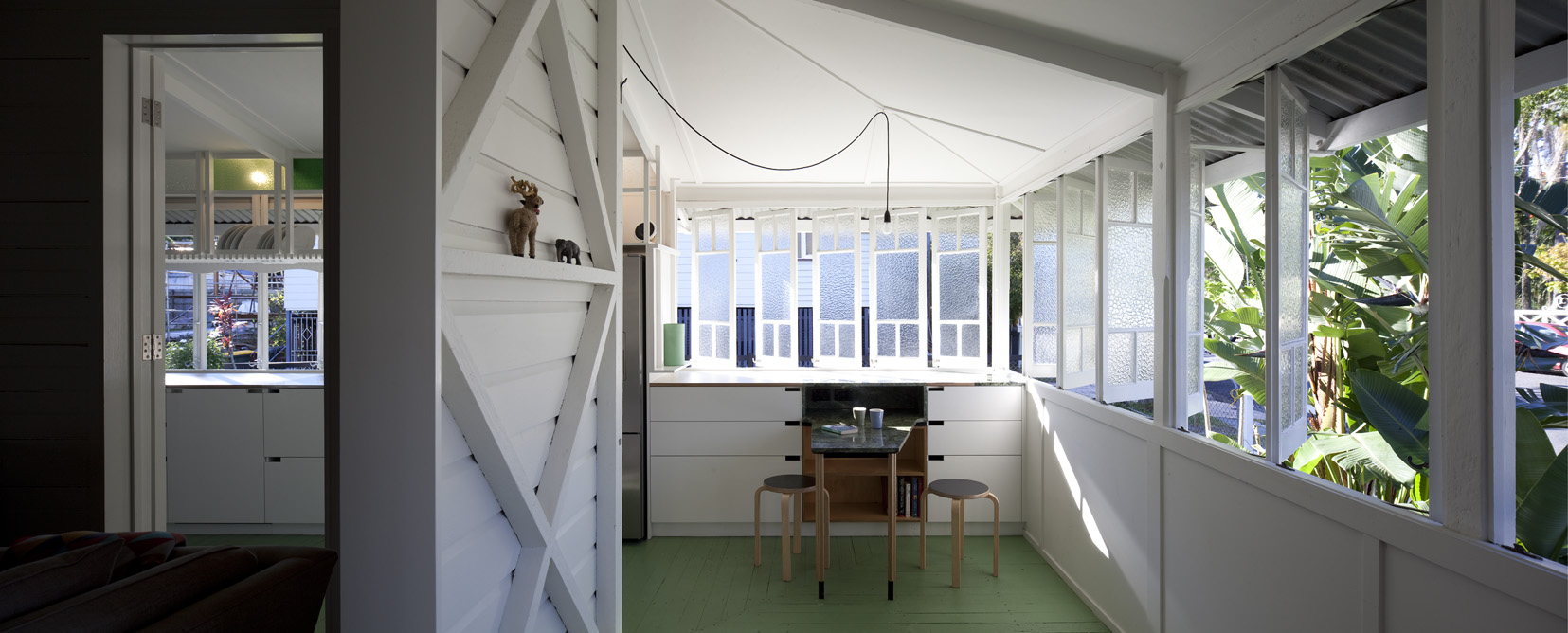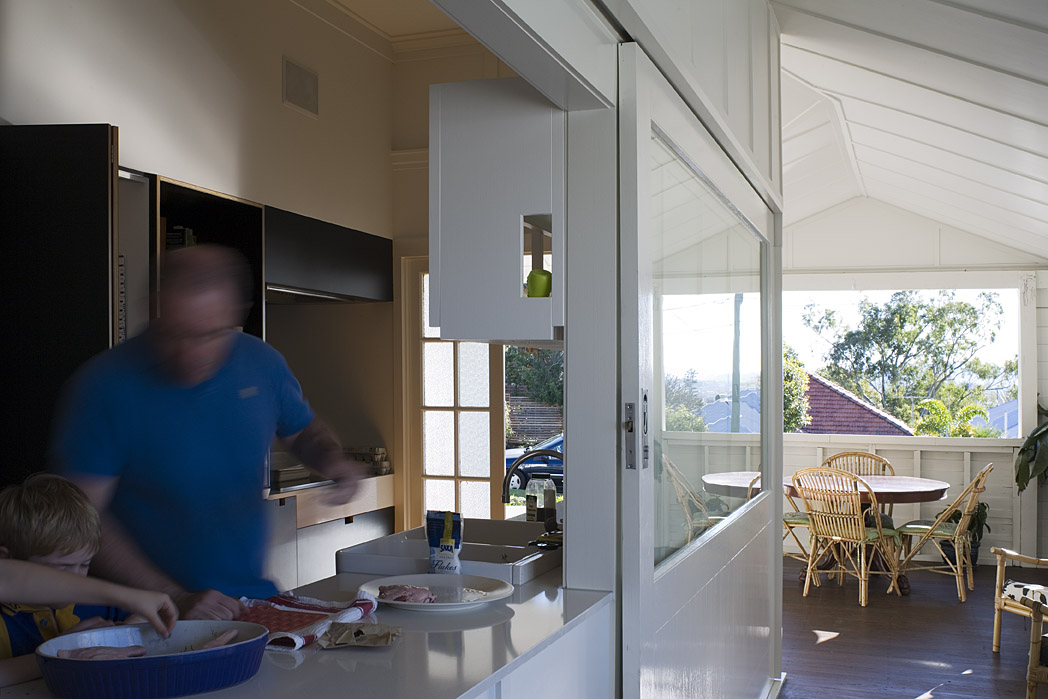Imagine a Street
September 2018
Lecture presented at: The Architecture Symposium, National Gallery of NSW
Words by Stuart Vokes
Images: Jon Linkins, Christopher Frederick Jones
September 2018
Lecture presented at: The Architecture Symposium, National Gallery of NSW
Words by Stuart Vokes
Images: Jon Linkins, Christopher Frederick Jones
1. A
Room in a City
I’d like to begin with something that I admire – it’s a small room in Brisbane that I come home to every night, and despite the ugly security bars that allow us to sleep at night with the windows open, it’s probably my favourite room in our house.
The room sits elevated above our front garden, overlooking a suburban street. It’s a robust and agile room that can be opened to the fresh air in summer or closed up during thunderstorms and when it is too cold.
It’s a room for one person to read a book on the daybed or take a nap on Saturday afternoon after the kids’ football matches. It’s a room for big occasions and family gatherings, with twenty people, crowded onto a bench seat, gathered around a long table. It has the character of a verandah, but inside, but never really inside – the kind of room that permits shoes to be left on. The floor is painted green, kind of like an internal lawn. The colour-coding of the floor belongs to a mapping differentiating the space from the other ‘inside’ rooms of the house.
One can be poetic about a house and describe it as a city in miniature – and just like the city, one can find a range of rooms, enabling a range of events and behaviours satisfying the spectrum of human emotions. But I am equally satisfied with the idea that a house might simply be thought of as a room in a city – a room where we feel at home, the one place left in the city where we might find real silence and real contentment. A house needn’t be yet another public place in order to play a critical role in the city fabric.

2.
Custodianship of a City
Having spent much of our practice life working on small suburban backyard projects in Brisbane, it would have been easy to imagine that these small, dispersed and discreet works were of little consequence to the civic life of the city. However, in time, we came to understand that each of our projects represented an opportunity to make a relevant work of architecture; one that contributes to a broader city-making project.
Some years ago we mapped our projects over a satellite photo of Brisbane. What became apparent when looking at this image was that, when considered collectively, the scale of these small projects might equate in size and influence to a large civic building, perhaps even affecting a similar number of people daily.
We realised that house by house, backyard by backyard, we were engaged in critical city-making. Our manipulation of building form, facades and private open space in the low-density suburban setting provided an opportunity for us to participate in a form of custodianship of the city.
3.
Productivity and Civility of Private Open Space
Low-density Australian cities, like Brisbane, have been long criticised for being unproductive, inefficient and a gross waste of resources and space. University of Queensland research fellow Greg Bamford reminds us that we need to make a careful and proper accounting of private open space in cities. His work offers a provocative counterpoint to more disparaging views of suburbia.
A cursory glance at the Brisbane suburban landscape reveals the scale of productivity relating to the household economy, daily routines, chores and rituals, and the production of ‘human capital’: here someone keeps a boat, restores a collection of old Holden cars, grows vegetables, dries the laundry, harvests rainwater, collects eggs, brews beer in a backyard shed, cultivates roses, trampolines after school, washes the family pet, and makes repairs to a bicycle. The resulting opportunities for learning, cognitive development, and the benefits for mental health and personal well-being are easily overlooked.
There is an urbanism here built on suburban narratives, stories of place, culture and its values. There is civility in the low-density suburbs conveyed through the occupation of private open space. It is transmitted through its margins, most importantly at the threshold between backyards and between a house and a street.
4.
Imagine a Street
![]()
![]()
![]()
![]()
![]()
![]()






So how might we critique a house, particularly in a city that is losing vast swathes of private open space to increases in built-densities? Do we observe each house in isolation or could we instead critique a house by imagining what kind of street it would make if we were to replicate it along the length of that street? What if we were to multiply these imagined streets across several blocks - what kind of neighbourhood, locale, or metropolis would this house generate?
I like to imagine each domestic event as being paired with a room, and each room having a relationship to its setting, producing a particular kind of urbanism derived from human occupancy.
So, imagine a street where a kitchen is relocated to the front room of a house and the family dine on the front verandah where they can call out salutations to passing neighbours and a child’s meal-time behaviour is mollified by the knowledge that passersby might be listening.
Imagine a street where a verandah becomes an inside room and daily routines such as checking emails and making coffee happen on the edge of the street like in a café.
Imagine a street where a house offers a deep garden frontage to the street, where one can see kids burning wood on an open fire pit.
Imagine a street where the house is set back to create a generous verge, and on this verge, there is a brick bench where parents can socialise with neighbours and watch their children learn how to ride bikes in the quiet cul-de-sac.
Imagine a street where an outdoor room flanks the public footpath. The room is furnished with a long bench seat and a brick fireplace. Its compressed volume accentuates the infinite scale of the cloistered garden alongside, a place of the ground and the sky, a place that allies domestic daily rituals with the profundity of nature and the cosmos.
Imagine a street where an open, domestic dining room establishes a generous public/private relationship with its setting - akin to that of a vibrant neighbourhood bistro – as a result of its proximity to the street, its domestic courtyard garden, and an adjacent public park on the hill.
5. Closing
The act of imagining a street poses provocative, apposite questions for an architect. It has given us a framework for placing our work within the broader narrative of the city and has helped us recognise the contribution that our projects might make to the urbanism of their neighbourhoods.
We are indebted to the decades of research undertaken by Greg Bamford. His written work has provided us with words and insight in the early years of practice life when we struggled to articulate what it was that we thought was valuable and humane about a city like Brisbane. Greg’s work showed us the civility in our suburbs.